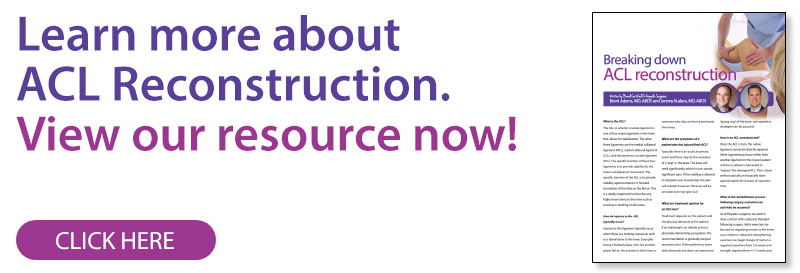Sports are a great way to stay active, but they can also cause common injuries, such as shoulder, ankle, and knee injuries. Our clinic helps patients who have sustained a shoulder, ankle, or knee injury. Even though sports are a fun way to stay physically fit, it’s important to understand common injuries associated with sports so that you can try to avoid them.
When it comes to injuries, understanding how they happen can help prevent them, and prevention is the best cure. If you have sustained an injury, though, understanding the healing and rehabilitative process are important, since both are a vital process of recovering and returning to the sports you love.
Shoulder Separation vs. Shoulder Dislocation
Many different injuries can happen to the shoulder region as a result of an athletic injury. One of the more common injuries is a shoulder separation, which is often confused with a shoulder dislocation. A shoulder separation is an injury to the acromioclavicular joint, or the joint that joins the collarbone to the shoulder blade or scapula. This injury can often be treated with non-operative management, usually consisting of rest and physical therapy.
A shoulder dislocation is a much different injury and can require sedation in order to have the joint reduced or put back in place. Often, the result of a shoulder dislocation is a labral tear. This is a tear to the tissue around the socket of the joint and can make an athlete more susceptible to future dislocation. A labral tear can be fixed surgically, but it is often managed with physical therapy and bracing during an athlete’s sport season.
Ankle Injuries
Ankle injuries are very common in athletic activities such as basketball, football, soccer, and volleyball. The most common injury is an ankle sprain. There are ligaments on the side of the ankle that provides most of the stability to the ankle. Most of the time, ankle sprains are managed conservatively with rest, ice, and elevation.
However, a simple ankle sprain can cause a more serious injury, such as an injury to the cartilage in the joint. Therefore, all severe ankle sprains should be seen by a car provider so that an x-ray can provide clarity on the seriousness of the injury.
Other injuries to the ankle may also be discovered with an x-ray that may otherwise be missed. Physical therapy following an ankle sprain can also be instrumental in avoiding future ankle sprains and should be strongly considered with all ankle sprains.
Knee Injuries
Knee injuries are very common in fall sports. Specifically, football, soccer, and gymnastics are common sports for injuries to the knee because of the cutting and stopping that is required in these activities. The most infamous injury to the knee is an ACL injury, otherwise known as anterior cruciate ligament injury. The ACL is one of the four major ligaments in the knee. ACL injuries typically occur when there is a twisting maneuver and/or a lateral blow to the knee.
Examples of this include a football player who has another player fall on the outside of his knee, or someone who slips on the ice and twists his or her knee. Typically, there is a sensation of a “pop” in the knee and significant swelling follows. An ACL deficient knees is unstable, and an athlete will be unable to “make a cut” on the knee without it giving way.
The only way to return successfully to competitive athletics is to have a surgical reconstruction of the ACL, which is done arthroscopically, rather than “open knee” surgery. This is a straightforward operation performed with a scope, and with a successful surgery and disciplined physical therapy, the athlete should be able to return to competition in six months.
Whether it’s a shoulder, ankle, or knee injury, most athletes who receive good care and quality, guided rehabilitation are able to return to competition. These injuries are never fun, especially since they hamper one from being active and participating in sports. At Yankton Medical Clinic, however, our orthopedic team is here to help you get back in the game safely and as soon as possible.

